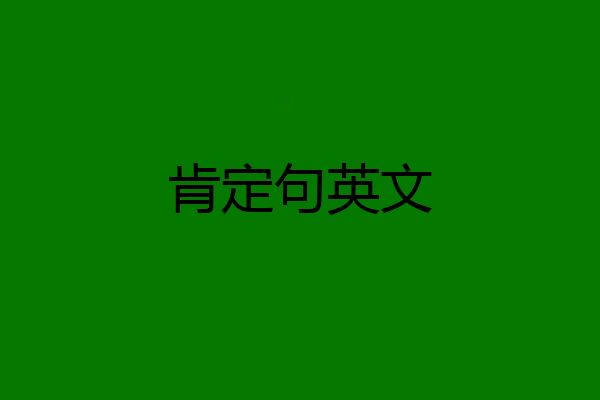
原来我在这里8
英文句子种类:肯定句和否定句含否定词的句子称为否定句(Negative Sentence),不含否定词的句子就称为肯定句(Affirmative Sentence)。例如:例:Mr. Walker is an Englishman.(华克先生是英国人。——肯定句)例:He is not an American.(他不是美国人。——否定句)简单地说,表达事物的“Yes”这一面的句子就是肯定句,“No”的一面的就叫做否定句。传统的英语入门都是先学肯定句,然后再学肯定句的反面,亦就是否定句。否定句的表达方式基本上有下面的两种。(1)使用副词否定词“not”,例如:(a)be,have为主要动词:例:I am not a good swimmer.(我不是一个游泳的好手。)例:He was not at home yesterday afternoon.(昨天下午他不在家。)例:I have not much money.(我没有很多钱。)例:He has not many friend here.(在这里他没有很多朋友。)解说“be/have +not”常缩短成一词,尤其是日常谈话更是如此。例如:例:You aren't [a:nt] a friend of his, are you ?(你不是他的朋友吧,是不是?)例:He isn't [>!znt] my brother.(他不是我的兄弟。)例:I wasn't [>w&znt] there at that time.(当时我没有在那儿。)例:There weren't [w+:nt] many people at the party yesterday.(昨天没有很多人参加宴会。)“am +not”不是“amn't”,而是“aren't”或“ain't[eint]”,例如:例:I ain't ready.(我还没准备好。)例:I am very nice to you, aren't I?(我对你很不错,是不是?)美国人用“ain't”很随便,应该是“are not,is not,have not,has not”的地方,他们也会“ain't”一下就带过去,宜注意。下面例句是“have not,has not”的缩短形。例:I haven't[>h$vnt] a headache.(我没有头痛。)例:He hasn't[>h$znt] come yet.(他还没来。)(b)be,have为助动词例:You aren't going to go to her birthday party, are you?(你不打算参加她的生日宴会,是不是?)例:It isn't raining outside.(外面没有在下雨。)例:She wasn't asked to speak at the meeting.(她没有被请求在会上讲话。)例:I haven't done anything wrong to her.(他没有做对不起她的事。)例:He hasn't yet paid the money.(他尚未付钱。)be+ V -ing(进行时),be +P.P.(过去分词)(被动词态),have(has,had)+P.P.(完成时)等的“be,have(has,had)”皆为助动词。例1的“be going to …”在学校文法中也常被视为助动词。(c)“助动词+V”时动词带有助动词“will,shall,can,may,must,need,dare,ought to,used to,had better”等时,将“not”置于助动词与主要动词之间。例如:例:I will not do it again.I won't[wount] do it again.(我不愿意再做这种事。)例:The old man cannot find his way home.(那个老人找不到回家的路。)例:I couldn't sleep last night.(昨夜我无法入睡。)例:You ought not to swim in the river.(你不应该在河里游泳。)例:You had better not tell her everything.(你最好不要样样事情都告诉她。)注:“can”的否定形式是“cannot or can't”,不可写成“can not or cann't”。(d)使用助动词“do”的否定句一般动词的否定句通常使用助动词“do”,句式如下:句型 do(does, did)+not + V(原形动词)例:I don't know her very well.(我并不很了解她。)例:He doesn't like Chinese tea very much.(他并不很喜欢中国茶。)例:She didn't come to school this morning.(今天早上她没有来上学。)例:Don't believe him.(不要相信他的话。)注:“have”表达“有”以外的意义时,其否定句通常使用助动词“do”,例如:例:Usually I don't have (=eat) breakfast on Sunday morning.(通常星期天早上我不吃早餐。)例:She doesn't have (=drink) coffee for breakfast.(她不把咖啡充作早餐喝。)例:We didn't have (=enjoy) a good time there yesterday.(昨天我们在那里玩得不愉快。)不过美式英语“have”作“有”的意义使用时也如一般动词使用助动词“do”,例如:例:I don't have brothers.(我没有兄弟。)例:We didn't have time enough to finish the work.(我们当时没有足够的时间完成那件工作。)(2)使用“not”以外的否定词“not”以外的否定词有:(a)副词:never,seldom,hardly,little,neither,etc.例:She never comes to school late.(他上学从不迟到。)例:She seldom comes to see me.(她不常来看我。)(b)形容词:no,few,little,etc.例:I have no brothers.(=I don't have brothers.)(我没有兄弟。)例:He has few friends in Hong Kong.(他在香港几乎没有朋友。)(c)代词:nothing,nobody,none,etc.例:I know nothing about computer.(对于电脑我一窍不通。)I found nobody about computer.(在那栋房子里我没看到任何人。)注:1.有些文法书认为“Not +V”为句子否定法,是否定句,而“no +n.或如nothing,etc.”为单词否定法,不宜称为否定句。例如:例:He doesn't have brother.(否定句)He has no brothers.(单词否定,但应视为肯定句,因为谓语动词是肯定。)请注意下面两句的意义上的区别。例:He doesn't have a breakfast.He has not a breakfast.(他不吃早餐。——否定句)例:He has no breakfast.(他没有早餐可吃。——单词否定,肯定句)2.否定也可以借用前缀或后缀来表达,例如:例:He is honest.(他是诚实的。)He is dishonest.(=He in not honest.)(他不诚实。)例:They have children.(他们有小孩。)They are childless.(=The don't have children.)(他们没有小孩。)Drilling Square


巫毒小子
一.肯定句:是指用肯定的语气来陈述的句子。
例:
This is my pen。
这是我的笔。
He works in a hospital。
他在医院工作。
There are four fans in our classroom。
我们教室里有四个风扇。
二.否定句:含有否定词或表示否定意义词的句子。
例:
This is not my pen。
这不是我的笔。
He does not (doesn’t) work in a hospital。
他不在医院工作。
There are not (aren’t) four fans in our classroom。
我们教室没有四个风扇。
三.肯定变否定,有以下2种情况
1.有am / is / are,就在它们后面加 not。
am → am not
is → is not
are → are not
比如:
I am a girl。→ I am not a girl。
我是女孩。→我不是女孩。
2.没有 am / is /are, 但有表示动作的动词(比如eat),就在动词前加 don't 或 doesn't, 动词为原形。
V原→ don't + V原
V(-s, -es结尾) → doesn't + V原
eat → don't eat
eats → doesn't eat
比如:
I drink cola。→I don't drink cola。
我喝可乐。→我不喝可乐。
She drinks cola。→ She doesn't drink cola。
她喝可乐。→她不喝可乐。
扩展资料
一.否定句主要是在肯定句的基础上加上了否定词 “not”。
二.有动词be的句子则“not”加在be后面,可缩写成“isn’t,aren’t”,但am not 一般都分开写。
三.没有动词be的句子则要先在主要动词的前面加上一个助动词(do,does,did),然后在它后面加上“not”,你也可以把它们缩写在一起如“don’t , doesn’t , didn’t )。
四.上面三个助动词要根据人称和时态来选择,其中“does”只用于一般现在时主语是第三人称单数的情况,而“did”只用于一般过去时,不论主语是什么人称和数,都用“did” 。

曼妙樱花
一.肯定句:是指用肯定的语气来陈述的句子。例:This is my pen。这是我的笔。He works in a hospital。他在医院工作。There are four fans in our classroom。我们教室里有四个风扇。

晓布丁2011
1、They are good friends.
他们是好朋友。
2、I am a bus driver.
我是一个公共汽车司机。
3、The dog can jump.
那只狗可以跳跃。
4、We come from China.
我们来自中国。
5、It’s time for sports.
运动的时间到了。
6、Tom’s brother is walking in the park.
汤姆的哥哥向公园跑来了。
7、His father is driving a bus.
他父亲正在开公共汽车。
8、The students of Class 5 are cleaning the classroom.
五班的学生正在打扫教室。
9、Their dog is playing in the room.
他们的狗在房间里玩。
10、Tom and Mary are friends.
汤姆和玛莉是好朋友。
11、These buses are new.
这些公共汽车是新的。
12、There are some books in the bookcase.
书柜里有一些书。
13、There is a banana in the box.
盒子里有一根香蕉。
14、I’m a student.
我是一个学生。
15、She is a farmer.
她是一个农民。
16、Your father can ride a bike.
你父亲会骑自行车。
17、Mr.Li can draw pictures.
李先生会画画。
18、They can play football after school.
放学后他们可以踢足球。
19、Today is Monday.
今天是星期一。
20、I can go to Shanghai Zoo.
我可以去上海动物园了。
扩展资料
在英语中常可见到一些形式上否定而意义上则表肯定的句子:
1、cannot…too You cannot betoo careful.
释义:你越小心越好。
英语说的cannot…too,意为“就算再……也不过分”或“越……越好”,其中的can表示可能性,too有over之意,可以换用enough或sufficient等字样。同时,在not的位置换用其他的否定词,如hardly,scarcely等也是可以的。
2、It is a good horse that never stumbles.
释义:再好的马也有失蹄的时候。
这个句子属于“It beadjective noun that…”句型。该句型多出现在一些谚语中,在某些情况下,这种句型需要从反面解释。

小乐乐9
1.The students have read about twenty English novels in the past three years. 2.I have my homework finished . 3.He has painted the front door green. 4.I've written an article. 5.It has been raining these days. 6.I have come fro。

kimiko范范
一.肯定句变成否定句 如果句中有be动词is,am,are 或情态动词must,can等,在其后面直接加not, she is your mother. she isn't your mother 2.如果没有be动词或情态动词,加don't,does't或did't she likes playing football. she doesn't like playing football.二.肯定句变成疑问句 变成一般疑问句如果有be或情态动词动词就把他们提前, she is your mother. Is she your mother? 2.如果没有就在前面加do的某种形式,第三人称用does,过去时用did she likes playing football. Does she like playing football? 变成特殊疑问句, 要具体分析,看是对什么进行提问,简单来说, 1.对人提问用who, she is your sister.Who is your sister? 2.对事物用what, The book is on the desk. what it is on the desk? 3对时间用when, She will come back tomorrow. When she will come back? 4.对频率用how often等等 I play football everyday. How often does you play footall?